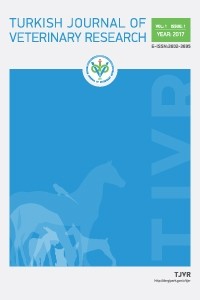Investigation of the Morphologic and Scanned Electron Microscopic Properties of Wild Boar Bristles in the Balikesir Region
Investigation of the Morphologic and Scanned Electron Microscopic Properties of Wild Boar Bristles in the Balikesir Region
Bristle Pig, SEM, Stereo microscope.,
___
- Amerasinghe FP. The structure and identification of the hairs of the mammals of Sri Lanka. Ceylon J Sci. 1983; 16:76-125.
- Andy A, Tillman C. Surface scanning electron microscopy of suri alpaca fiber and other members of the camel family. Science. 2006; 311:85-171.
- Aris FP, George C. Morphology of the hair in the Goat breed Capra prisca. J Anim Vet Adv. 2008; 7(9):1142-1145.
- Breehl L, Caban O. Physiology, Puberty. Treasure Island: StatPearls StatPearls Publishing; (FL):2002.
- Choudhary OP, Dhote BS, Bharti SK, Sathapathy S. The advantages of the scanning electron microscope in the forensic studies of hair in domesticated and wild animals. J Forensic Sci. 2012; 3(2): 191-192.
- De Marinis AM, Asprea A. Hair identification key of wild and domestic ungulates from southern Europe. Wildlife Biol. 2006; 12(3):305-320.
- Dehury S, Mishra UK, Hembram A, Sahoo N. Light and scanning electron microscopy analysis of hair samples of some wild animals for individual identification. J Entomol Zool Stud. 2019; 7(6):900-904.
- Grubbs H, Nassereddin A, Morrison M. Embryology, Hair. Treasure Island: StatPearls StatPearls Publishing; 2022.
- Hess WM, Flinders J, Pritchett CL, Allen JV. Characterization of hair morphology in families Tayassuidae and Suidae with scanning electron microscopy. J Mammal. 1985; 66(1):75-84.
- Hino H, Ammitzboll T, Moller R, Asboe-Hansen G. Ultrastructure of skin and hair of an Egyptian mummy. J. Cutaneous Pathol. 1982; 9:25-82.
- Jędrzejewski W, Jędrzejewska B, Okarma H, Ruprecht AL. Wolf predation and snow cover as mortality factors in the ungulate community of the Białowieża National Park, Poland. Oecologia. 1992; 90(1):27-36.
- Johnson E, Hornby J. Age and seasonal coat changes in long-haired and normal Fallow deer (Dama dama). J Zool.1980; 192(4):501-509.
- Kennedy AJ, Carbyn LN. Identification of wolf prey using hair and feather remains: with special reference to Western Canadian National Parks. Canadian Wildlife Service, Western and Northern Region. 1981.
- Koppiker BR, Sabnis JH. Further studies on the identification of hairs of some Indian mammals. JBNHS. 1977; 74:50-59.
- Marchinton RL, Aiken RB, Henry VG. Split guard hairs in both domestic and European wild swine. J Wildl. 1974; 38(2): 361-362.
- Maxwell DJ, Bannatyne BA, Fyffe REW, Brown AG. Ultrastructure of hair follicle afferent fiber terminations in the spinal cord of the cat. J Neurocytol. 1982; 11:571-582.
- Mayer JJ, Brisbin IL. Wild Pigs of the United States. Their history, morphology and current status. Athens: University of Georgia Press; 1991. pp.313.
- Meyer W, Pohlmeyer K, Schnapper A, Hülmann G. Subgroup differentiation in the Cervidae by hair cuticle analysis. Zeitschrift für Jagdwissenschaft. 2001; 47:253-258.
- Muto H, Ozeki N, Yoshioka I. Fine structure of the fully keratinized hair cuticle in the head hair of the human. Acta Anat. 1981; 109:13-18.
- Nowak B. Contents and relationship of elements in human hair for a non-industrialized population in Poland. Sci Total Environ. 1998; 209(1):59-68.
- Oli MK. A key for the identification of the hair of mammals of a snow leopard (Panthera uncia) habitat in Nepal. J Zool. 1993; 231(1):71-93.
- Raphael KA, Chapman RE, Frith PA, Pennycuik PR. The structure of hair and follicles of mice carrying the naked (N) gene. Gertpt Res. Cambridge. 1982; 39:139-148.
- Riggott JM, Wyatt EH. Scanning electron microscopy of hair from different regions of the body of the rat. J Anat. 1980; 139:121-12.
- Ryder ML. A study of the coat of the Mouflon Ovis musimon with special reference to seasonal change. UK: Blackwell Publishing; 1960. p.387-408.
- Short HL. Analysis of cuticular scales on hairs using the scanning electron microscope. J Mammal. 1978; 59(2):261-268.
- Slepecky N, Hamernik R, Henderson D. The consistent occurrence of a striated organelle (Friedmann body) in the inner hair cells of the normal chinchilla. Acta Otolaryngol. 1981; 91:189-198.
- Taru P, Backwell L. Identification of fossil hairs in Parahyaena brunnea coprolites from Middle Pleistocene deposits at Gladysvale cave, South Africa. J Archaeol Sci. 2013; 40(10):3674-3685.
- Valente A. Hair structure of woolly mammoth mammuthus primigenius and the modern elephant, Elephas maximus and loxodont. J Afr Zool. 1983; 199(2):271-274.
- Wallis RL. A key for the identification of some Ontario mammals. Can J Zool. 1993; 71(3):587-591.
- Weedon D, Strutton G. Apoptosis as the mechanism of the involution of hair follicles in catagen transformation. Acta Dermato (Stockholm). 1981; 61:335-369.
- Welle MM, Wiener DJ. The hair follicle: a comparative review of canine hair follicle anatomy and physiology. Toxicol Pathol. 2016; 44(4):564-574.
- Başlangıç: 2017
- Yayıncı: Ebubekir CEYLAN
Güngör Çağdaş DİNÇEL, Orhan YAVUZ, Serkan YILDIRIM
Mucins: an overview of functions and biological activity
Habibe GÜNDOĞDU, Ebru KARADAĞ SARI
Sero-epidemiology of bovine tuberculosis in dairy cattle in Chattogram, Bangladesh
Mohammad Belayet HOSSAİN, Md. Abu SAYEED, Md. Shohel Al FARUK, Md. Mamun KHAN, Md. Aftabuddin RUMİ, Md. Ahasanul HOQUE
A Study on Morphological and Morphometrical Parameters on the Skull of the Konya Merino Sheep
Zekeriya ÖZÜDOĞRU, Derviş ÖZDEMİR, Bumin Emre TEKE, Mesut KIRBAŞ
Şükrü Hakan ATALGIN, Mehmet CAN, Alper ÇELENK
Bahat COMBA, Serkan YILDIRIM, Arzu COMBA, Gönül ARSLAN AKVERAN
Nizamettin GÜNBATAR, Handan MERT, Salih ÇİBUK, Leyla MİS, Nihat MERT
Investigation of the Prevalence of Digestive System Parasites in Chickens in the Kirikkale Region
